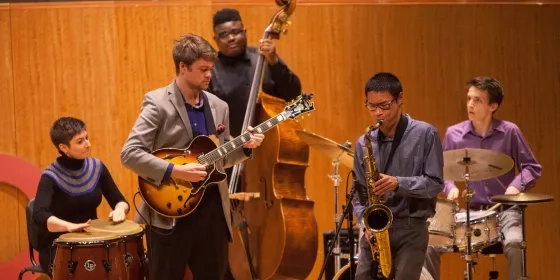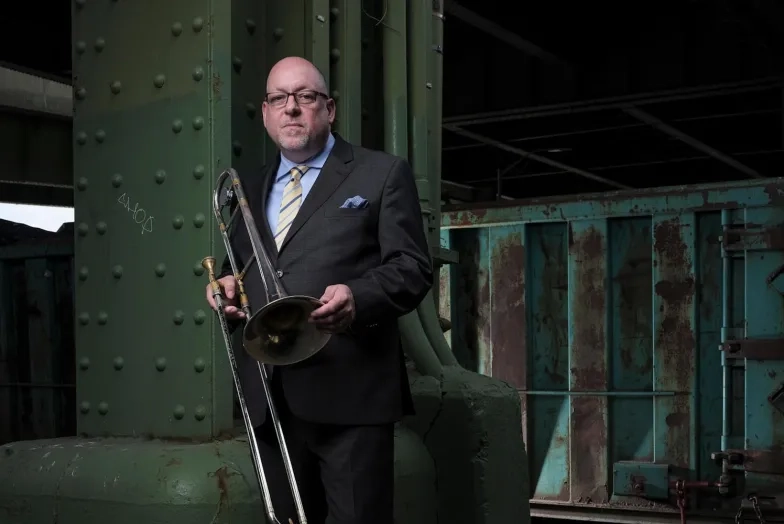The Beginning of RJAM at SFCM
News StoryWhile many SFCM students have taken time in the past month to reflect on their musical discipline’s evolution at the Conservatory, one group in particular has found themselves at the beginning of a new legacy. Thirteen Roots, Jazz, and American Music (RJAM) students have taken on the task of writing the future of the Conservatory by being the first class of students to major in jazz performance.
Because the new degree program is a collaboration between SFCM and SFJAZZ, students have already experienced access to transformative performance opportunities and teachers. Percussionist Amelie Hinman explains, “The program includes master classes, one-on-one lessons, and collaborative ensemble sessions that even allow us to share the stage with Grammy Award-winning and internationally acclaimed musicians who have joined the RJAM faculty.”
RJAM’s first concert at SFCM took place Saturday, September 30. The event—moved from Sol Joseph Recital Hall to Caroline H. Hume Concert Hall due to an overflowing crowd—attracted an audience eager to witness the birth of a promising, new program. SFJAZZ Collective members and other RJAM faculty such as Matt Penman, Chad Lefkowitz-Brown, and Carlos Caro joined with students for a fully collaborative performance.
And what a performance it was. In a review of the event, San Francisco Classical Voice noted, “The San Francisco Conservatory of Music’s new four-year bachelor’s degree program Roots, Jazz, and American Music (RJAM) is about a month old, but this baby is already swinging.” It also considered RJAM “a valuable new addition to the region’s rich jazz education infrastructure.”
Between hosting a monthly jam session at Bird and Beckett in Glen Park, taking the Conservatory’s Caroline H. Hume Concert Hall stage multiple times, and performing at the Monterey Jazz Festival, RJAM musicians find themselves immersed in a habit of performance. “Playing at the Monterey Jazz Festival was an incredible experience, really a bit surreal for me,” says bassist Knox Barber. “I figured it would take me a lot longer to make it to the point where I could be playing there.The RJAM program is providing us with a lot of great performance opportunities and I'm very grateful for that. There's nothing I love to do more than perform in some special venues.”
RJAM Executive Director Simon Rowe has been explicit and ambitious in his vision for “one of the most unique and distinctive jazz education programs in the country and internationally.” When his students took the stage at Monterey, the world was able to catch its first glimpse of the program. “They played a robust set of classic bop and post bop tunes by jazz legends including Horace Silver, Blue Mitchell, and Woody Shaw to a large and enthusiastic crowd,” Rowe explains. “There was great curiosity and excitement around this first contingent of our innovative new program… from students and the public alike.”
The experience of performing in Monterey has had reverberations in the classroom, where musicians draw connections between their diverse curriculum and their imminent careers as professional interpreters and performers of jazz. “Performing at Monterey allowed me to be familiarised and refreshed with what's happening in the jazz music scene in this country right now, and allowed me to make valuable connections for the future with other musicians my own age and beyond,” says tenor saxophonist Jayden Clark.
The classroom as a catalyst for the contextualization of modern jazz music is the focus of SFJAZZ Director of Education Rebeca Mauleón’s class African Roots of Jazz. She “immerses us in practical approaches towards understanding the roots of modern-day jazz and American music,” says Amelie Hinman. She goes on to describe the extreme diversity of their course load: “We get to join our classical colleagues at SFCM for the superb music theory and musicianship classes, as well as the new and outstanding courses focusing on professional development and management aspects of being a musician.”
The combined experience of performance opportunities, classroom training, and individual mentorship has already empowered RJAM students. "To be part of this innovative and courageous program, contributing to it as it unfolds, is a wonderful adventure and an honor,” Hinman concludes.
Jayden Clark agrees, “Performing alongside fellow RJAM peers and faculty has been a very positive experience and has allowed me to play at what I consider to be the highest level I've reached so far.”



